Physical Address
304 North Cardinal St.
Dorchester Center, MA 02124
Subcutaneous mycoses are a group of fungal diseases produced by a heterogeneous group of fungi that infect the skin, subcutaneous tissue, and in some cases the underlying tissues and organs. The causative agents are commonly found in the soil, leaves, and organic material, and are introduced by traumatic injury of the skin. The diseases usually remain localized and slowly spread to the surrounding tissue; symptoms are usually minimal or absent. On rare occasions, lymphatic and hematogenous spreading of the infection can occur. Most of the causative organisms of subcutaneous mycoses have been cultured from the affected tissues, and identified by histopathologic examination. One of them, Lacazia loboi , has not been cultivated in vitro. Rhinosporidium seeberi causing rhinosporidiosis has been reclassified as a protist. Mycetoma can be produced by eumycetes or bacteria belonging to the aerobic actinomycetes group, which causes more than 50% of the total cases reported worldwide. In some geographic areas, the predominant agents of this disease vary.
The fungi producing sporotrichosis and cutaneous mucormycosis are also found worldwide. Other organisms, like those causing chromomycosis and mycetoma – eumycetoma and actinomycetoma – are mainly found in tropical and subtropical regions. Rhinosporidiosis, entomopthoromycosis, and Lobo's disease are limited to some areas in Central and South America as well as Africa. Rhinosporidiosis has been reported in India, the Americas, Africa, Asia, and occasionally in Europe.
The clinical picture varies among the different diseases, but the appearance of a localized nodule, verrucous plaques, ulcerations, granulomatous tissue, subcutaneous tumors with abscesses, and fistulae should alert the clinician to the diagnosis of a subcutaneous mycosis. It is important to consider the places where the patient has lived or traveled, and the geographic epidemiology of fungal and aerobic actinomycete infections in those areas. The differential diagnosis is generally made with mycobacterial infections, other bacterial, parasitic, and fungal infections, as well as neoplasms.
The diagnosis is based on the demonstration of the causative agents either by direct observation of the fungal structures in the material from the lesions with potassium hydroxide or by histopathologic studies with specific stains such as periodic acid–Schiff (PAS) or Gomori–Groccott. The isolation of the etiologic agent by either culture or molecular techniques (polymerase chain reaction, PCR) confirms the diagnosis and allows the clinician to select the best treatment.
Mycetoma is caused by aerobic actinomycetes (actinomycetoma) or fungi (eumycetoma).
It predominates in farmers and frequently affects the feet and legs.
The differential diagnosis includes subcutaneous and systemic mycosis, and mycobacterial infections.
Treatment of actinomycetoma is based on antibiotics. Severe and resistant cases need combination treatments such as amikacin with trimethoprim-sulfamethoxazole.
Eumycetoma therapy often requires oral antifungals and surgery.
Mycetoma is a chronic infection of the skin and subcutaneous tissue that can involve deeper structures such as the fasciae, muscles, and bones; it is acquired by traumatic inoculation of the etiologic agent. Clinically it is characterized by an increased volume of the affected area, fibrosis, tumefaction, and the formation of abscesses that drain pus-containing grains through fistulae. The grains represent an aggregate of hyphae produced by some species of fungi – eumycotic mycetoma – or bacterial filaments from aerobic actinomycetes – actinomycotic mycetoma.
Table 18-1 presents the basic differences between diseases that have grains. This confusion is further aggravated by the fact that various etiologic agents of eumycetoma can also cause pheo-hyphomycosis, chromoblastomycosis, and hyalohyphomycosis.
| Clinical Entity | Infection Sites | Sources | Etiologic Agents |
|---|---|---|---|
| Mycetoma | Subcutaneous | Exogenous (traumatic inoculum) | Filamentous fungi or aerobic actinomycetes |
| Actinomycosis | Cervicofacial, pulmonary, abdominal, and pelvic | Endogenous (microbiota of the digestive and genital tracts) a | Anaerobic filamentous bacteria b |
| Botryomycosis | Subcutaneous and visceral | Microbiota of the skin and digestive tract a | Cocci and bacilli c |
Early diagnosis and proper treatments are crucial for avoiding complications and mutilating surgeries.
Mycetoma was first described by Gill in 1842 with the term “Madura foot”; in 1860 Carter introduced the term “mycetoma.” Later, Pinoy introduced the term “actinomycetoma” to designate those types produced by aerobic actinomycetes, and “eumycetoma” for those caused by true fungi.
Mycetoma is more commonly found in middle-aged males from rural areas (ratio 3 : 1), which reflects occupational contact with the microorganisms. These live saprophytically in nature, in soil and plants, deriving nutrition from organic material in decomposition. Some species have a worldwide distribution, whereas others are limited to some regions. The infection is more common in tropical and subtropical areas, and is endemic in India and various countries in Africa and the Americas. Both forms of mycetoma have been reported in areas with a temperate climate, such as the USA.
Saprophytic fungi or bacteria from the soil or plants penetrate the skin and subcutaneous tissue by traumatic implantation. The infection evolves slowly and can invade deeper structures including bone and underlying organs.
Approximately half of the cases are caused by fungi, amongst which the most frequently isolated are Madurella mycetomatis and M. grisea and, less frequently, Scedosporium apiospermum , Acremonium spp., Exophiala jeanselmei , and Leptosphaeria senegalensis .
The most common agents of actinomycetoma are Nocardia species, especially N. brasiliensis , which is the most frequent agent in many countries of the Americas. The literature reports several cases involving Actinomadura madurae and sporadic cases from Streptomyces somaliensis and A. pelletieri ( Box 18-1 ).
Actinomadura pelletieri
Actinomadura madurae
Nocardia brasiliensis
Nocardia asteroides
Nocardia otitidis caviarum (= N. caviae )
Streptomyces somaliensis
Scedosporium apiospermum ( Pseudallescheria boydii )
Acremonium kiliense , A. falciforme , A. recifei
Neotestudina rosatii
Fusarium moniliforme
Aspergillus nidulans ( Eumericella nidulans ), A. flavus
Madurella mycetomatis , M. grisea
Exophiala jeanselmei
Pyrenochaeta romeroi
Leptosphaeria senegalensis , L. tompkinsii
Curvularia lunata , C. geniculata
At the inoculation site, after a variable incubation period (weeks or months), a painless nodule appears that drains a serosanguineous or seropurulent secretion through fistulae. Contiguous, similar lesions appear, and after a period of 1 to several years, the affected area presents an increased volume, with numerous fistulae draining secretion with grains ( Figs. 18-1 and 18-2 ). Bones and ligaments may also be affected, the extent of which depends on the time of evolution of the disease and the pathogen's aggressiveness. Later stages involve skin hyperpigmentation, fibrosis, and local deformity. The presence of a secondary infection aggravates the inflammatory process. Actinomycetoma are usually more inflammatory and suppurative, whereas fibrosis and less secretion predominate in eumycetoma. Mycetomas are usually localized and unilateral.
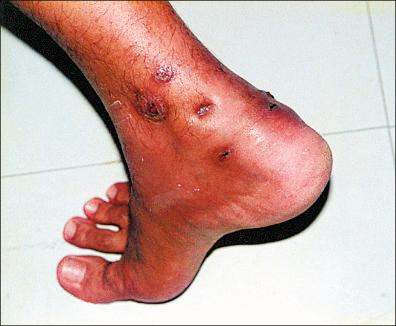
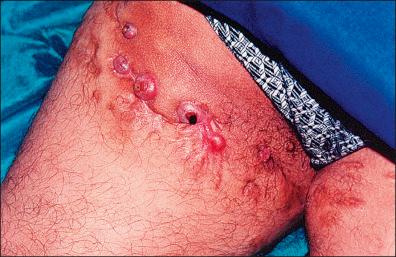
When mycetoma is suspected, one should investigate: (1) the history of trauma; (2) the presence of an increased volume of the affected site, formation of nodules, abscesses, fistulae, and drainage of grains; (3) the color and size of the grains, as well as their microscopic characteristics (10% potassium hydroxide fresh mount), which will help to classify the agent as either a fungus or filamentous bacteria, and in some organisms even suggest the specific etiologic agent; (4) the histopathology of the lesion; (5) culture for isolation and identification of the agent by PCR if needed; (6) imaging studies to evaluate the degree and extent of the lesion, including conventional X-ray, computed tomography, and magnetic resonance for detecting bone lesions and involvement in soft tissues.
Clinical differential diagnoses include botryomycosis, actinomycosis, chronic osteomyelitis, cutaneous tuberculosis, other fungal subcutaneous diseases, and tumors.
In histologic sections stained with hematoxylin and eosin (H&E), the grains are frequently observed surrounded by an accumulation of polymorphonuclear neutrophils producing microabscesses, chronic inflammatory infiltrate, and granulation tissue containing Langerhans cells and foam cells. By using H&E an experienced mycopathologist can identify A. pelletieri , A. madurae , and S. somaliensis grains based on their color, size, and morphology ( Fig. 18-3A and B ). Nocardia granules are small, oval, or lobular, and appear homogeneously stained with H&E; they may have peripheral clubs. In order to differentiate Nocardia from Actinomyces , different staining techniques for bacteria can be used, such as Gram, Brown–Brenn (both are Gram-positive), and Kinyoun; in general, Nocardia species are partially acid fast.
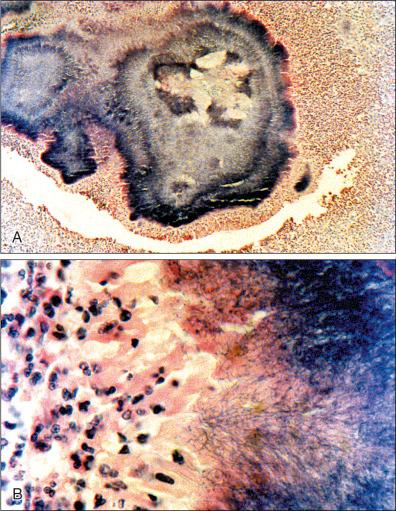
In eumycetoma it is possible to identify M. mycetomatis grains in sections stained with H&E. Other fungal agents require further investigation using PAS and Grocott staining, which shows the hyphae ( Fig. 18-4 ). In both actinomycetoma and eumycetoma, precise identification of the agent requires isolation in culture and subsequent identification using PCR. This technique allows the identification of the precise etiologic pathogen when there is uncertainty, and the characterization of new species.
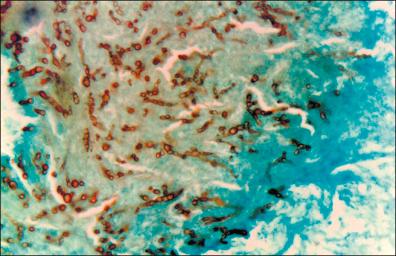
In the treatment of mycetoma it is extremely important to characterize the etiologic agent (or at least to determine the nature of the infection – whether bacterial or fungal – because of difference in treatment in each case) and the extent of tissue invasion.
Actinomycetoma caused by Nocardia is treated successfully with a combination of sulfamethoxazole (1200 mg) and trimethoprim (240 mg) (TMP-SMX) bid, and occasionally dapsone at a dose of 100–300 mg / day for 24–36 months. Minocycline 200 mg / day for 1–2 years is used to treat N. brasiliensis , N. asteroides , A. madura , and A. pelletieri . Amoxicillin (500 mg) and clavulanic acid (125 mg) tid for 6 months is used for N. brasiliensis . Amikacin (500 mg 12 / 12h) for 3 weeks followed by 2 weeks of rest has been reported to be useful in some cases. Amikacin in combination with TMP-SMX is the best treatment for those cases caused by N. brasiliensis and Actinomadura that are unresponsive to the conventional antimicrobials, or those with potential dissemination to underlying organs. The medication is given in 5-week cycles that consist of 15 mg / kg per day of amikacin for 3 weeks, and 5 weeks of TMP-SMX 80 : 40 mg / kg per day. One to five cycles are usually sufficient. Creatinine clearance and audiometry must be performed periodically during every cycle in order to detect any adverse effects of aminoglycoside. Other combination treatments include carbapenems, amoxicillin and clavulanic acid, rifampin, minocycline, and moxifloxacin. Linezolid can be useful as monotherapy in unresponsive to second- and third-line treatments.
The therapeutic response in eumycotic mycetoma is variable, and in many cases shows poor results. The drugs of choice are itraconazole (200–400 mg / day) and ketoconazole (400 mg / day), in countries where it is available, for 1 or 2 years or even for longer periods; amphotericin B, IV or intralesional (total dose 2.0–4.0 g) can be used in some cases. Treatment failure is explained by the low sensitivity of certain etiologic agents to current antifungals, and the intense fibrosis. Corticosteroids can be combined with antifungals for a short period to improve the inflammatory process. A combination of surgery and drug therapy is the best option in eumycetoma.
Sporotrichosis designates any disease caused by dimorphic fungi of the genus Sporothrix . This mycosis usually affects the dermis after traumatic inoculation. In humans the course can be acute or subacute, and lymphatic spread is typical. Mostly it is a benign disease. On rare occasions, however, systemic spread can be identified in the context of immunosuppression.
S. schenckii complex predominates in tropical and temperate zones with worldwide distribution. This saprophytic fungus is widely dispersed and is found in soil, organic matter, and plants. Classical infection is associated with traumatic inoculation of the fungus. Sporotrichosis is sometimes a zoonotic mycosis related to both armadillos and domestic cats.
Culture is the gold standard, resulting in the appearance of colonies within 3–5 days up to 4 weeks. Serology is almost always inconclusive.
Itraconazole is currently the treatment of choice for cutaneous sporotrichosis. Terbinafine is a fungicidal drug also effective in cutaneous sporotrichosis. Potassium iodine treatment remains as an effective and low-cost option for cutaneous sporotrichosis.
Sporotrichosis designates any disease caused by the dimorphic fungi of the genus Sporothrix . This mycosis usually affects the dermis after traumatic inoculation. In humans the course can be acute or subacute, and lymphatic spread is typical. Mostly it is a benign disease. On rare occasions, however, systemic spread can be identified in the context of immunosuppression.
Schenck described the first case of sporotrichosis, in 1898. In 1900, Hektoen and Perkins named the fungus responsible Sporothrix schenckii. This agent remained as the sole species of the genus Sporothrix until 2007. With the utilization of polyphasic taxonomy for fungal classification, S. schenckii became a complex that encompasses the following species: S.brasiliensis , S.globosa , S.mexicana, S. luriae, S. albicans , and S.schenckii.
S. schenckii complex predominates in tropical and temperate zones and has a worldwide distribution. This saprophytic fungus is widely dispersed and is found in soil, organic matter and plants. Classical infection is associated with traumatic inoculation of the fungus.
Sporotrichosis is sometimes a zoonotic mycosis. Armadillos can act as a reservoir, being able to inoculate the fungus through a scratch, without developing clinical disease. Cats can develop feline sporotrichosis – a severe, and often fatal, systemic disease. They can transmit the disease to other cats and humans through a scratch, bite and by exudates from the skin and respiratory tract. Sporadic reports of sporotrichosis transmitted by rats have also been made, a link that should be more explored.
Four epidemiologic contexts can be related to the disease:
Sporadic disease acquired after occasional traumatic inoculation of the fungus.
Occupational hazard in individuals exposed to the fungus, such as gardeners, veterinarians, and laboratory technicians.
Epidemic outbreak – in South Africa between 1941 and 1944 splinters from wooden beams infected 3300 miners. In the USA, especially in the Mississippi valley, work-related outbreaks in forests with pine seedlings and from disturbance of moss have been described.
Endemic zoonosis transmitted by cats has been observed since 1998 in Rio de Janeiro, Brazil. This zoonotic transmission is characterized by household contact with cats carrying sporotrichosis. This is an emerging mechanism of transmission with migration of contaminated animals.
Typically sporotrichosis is a benign disease, restricted to the skin and regional lymph nodes. There are four main clinical presentations :
Lymphocutaneous: this is the most common presentation of the disease and represents up to 70% of cases ( Fig. 18-5A ). After the trauma, the primary lesion arises within days or weeks. It begins as an erythematous papule. Nodule, ulcer (inoculation chancre), verrucous plaque, and gummas can also be present. Lymphangitis following the lymphatic drainage channels appears after the initial lesion. It is usually painless. Nodules are typically observed. The most common locations are the upper extremities.
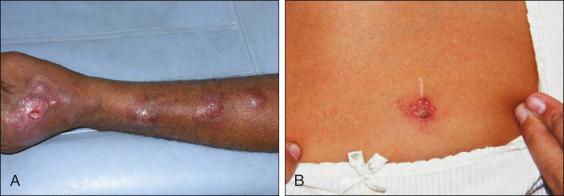
Cutaneous fixed: this is the second most common clinical presentation, occurring in 25% of cases ( Fig. 18-5B ). It is more frequent in children and individuals in good general health. There is no lymphatic spread.
Cutaneous disseminated: this typically afflicts patients with immunosuppression and it is believed to occur after hematogenous spread of the fungus to the skin. This is a rare clinical picture.
Extracutaneous disease: this comprises less than 5% of cases so is not usually suspected. It can be localized or disseminated. Immunosuppression is the most important risk factor. Any organ or tissue can be involved. Hematogenous spread is the most probable mechanism of dissemination of the parasite. Contiguous spread, atypical trauma, and inhalation of the fungus can lead to local extracutaneous disease. Monoarthritis of knee, elbow, ankle, and wrist are the most common joint manifestations. Bone disease may present with lytic lesions. The lungs can be primarily affected through inhalation of conidias. There may be various clinical presentations of eye disease: conjunctivitis, dacryocystitis ( Fig. 18-6 ), episcleritis, dacryocaniculitis, corneal ulceration, uveitis, nodular iritis, retrobulbar lesion panophthalmitis, ulceration corneal, or ectropia. Brain abscesses and chronic meningitis have been the reported as neurologic manifestations.
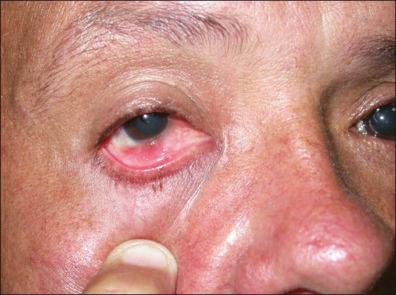
Reactive disease : a number of hypersensitivity diseases are now recognized to be indirectly related to the presence of the fungus, including arthralgia, inflammatory arthritis, erythema nodosum, erythema multiforme, and Sweet syndrome.
Sporotrichosis transmitted by cats : the cutaneous lymphatic and cutaneous fixed forms are the most common clinical presentations. However, disseminated and ocular disease are more frequently observed in healthy individuals. Sporotrichosis-associated hypersensitivity syndromes were first described in this epidemiologic context.
Sporotrichosis associated with HIV infection: the clinical forms of sporotrichosis vary according to a patient's immune status. It can be an opportunistic infection associated with AIDS (mean CD4 count 200 cells / µl) with cutaneous disseminated and extracutaneous diseases as the most common clinical presentation. The nasal mucosa is the most commonly afflicted extracutaneous site.
Become a Clinical Tree membership for Full access and enjoy Unlimited articles
If you are a member. Log in here